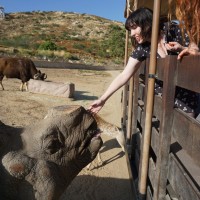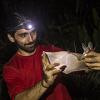Acoustic sensors enable efficient and non-invasive monitoring of a wide range of species, including many that are difficult to monitor in other ways. Although they were initially limited in application scope largely due to cost and hardware constraints, the development of low-cost, open-source models like the Audiomoth in recent years has increased access immensely and opened up new avenues of research. For example, some teams are using them to identify illicit human activities through the detection of associated sounds, like gunshots, vehicles, or chainsaws (e.g. OpenEars).
With this relatively novel dimension of wildlife monitoring rapidly advancing in both marine and terrestrial systems, it is crucial that we identify and share information about the utility and constraints of these sensors to inform efforts. A recent study identified advancements in hardware and machine learning applications, as well as early development of acoustic biodiversity indicators, as factors facilitating progress in the field. In terms of limitations, the authors highlight insufficient reference sound libraries, a lack of open-source audio processing tools, and a need for standardization of survey and analysis protocols. They also stress the importance of collaboration in moving forward, which is precisely what this group will aim to facilitate.
If you're new to acoustic monitoring and want to get up to speed on the basics, check out these beginner's resources and conversations from across the WILDLABS platform:
Three Resources for Beginners:
- Listening to Nature: The Emerging Field of Bioacoustics, Adam Welz
- Ecoacoustics and Biodiversity Monitoring, RSEC Journal
- Monitoring Ecosystems through Sound: The Present and Future of Passive Acoustics, Ella Browning and Rory Gibb
Three Forum Threads for Beginners:
- AudioMoth user guide | Tessa Rhinehart
- Audiomoth and Natterjack Monitoring (UK) | Stuart Newson
- Help with analysing bat recordings from Audiomoth | Carlos Abrahams
Three Tutorials for Beginners:
- "How do I perform automated recordings of bird assemblages?" | Carlos Abrahams, Tech Tutors
- "How do I scale up acoustic surveys with Audiomoths and automated processing?" | Tessa Rhinehart, Tech Tutors
- Acoustic Monitoring | David Watson, Ruby Lee, Andy Hill, and Dimitri Ponirakis, Virtual Meetups
Want to know more about acoustic monitoring and learn from experts in the WILDLABS community? Jump into the discussion in our Acoustic Monitoring group!
Header image: Carly Batist
April 2024
June 2024
July 2024
event
November 2023
event
| Description | Activity | Replies | Groups | Updated |
|---|---|---|---|---|
| Yeah, it's an exciting project. Also will be a great excuse to improve PAMGuard documentation - something sorely needed. Python libraries also on the way as part of this.As for... |
|
Acoustics | 1 year 5 months ago | |
| Yes, that looks effective! |
|
Acoustics | 1 year 5 months ago | |
| Hi Alex,I'd go much further along the lines that David @dtsavage sets out. Before jumping to implementations, better think through why you want to keep all that data, and for who... |
|
Acoustics, Data management and processing tools | 1 year 5 months ago | |
| The open-source program Audacity can show the spectrograms and histograms and has quite a lot of other useful features, e.g. playing ultrasound calls slower, so it can be heard by... |
|
Acoustics, Citizen Science, Data management and processing tools, Open Source Solutions, Software and Mobile Apps | 1 year 5 months ago | |
| Thanks so much!! |
|
Acoustics, AI for Conservation, Biologging, Camera Traps, Community Base, Data management and processing tools, Drones, eDNA & Genomics, Emerging Tech, Open Source Solutions, Remote Sensing & GIS, Software and Mobile Apps | 1 year 6 months ago | |
| I love the idea of increasing international collaboration and inclusion within acoustic monitoring! I think there particularly needs to be more collab'ing between the terrestrial... |
|
Acoustics | 1 year 6 months ago | |
| Hi there Camilo, What an interesting project! If you are looking for a lower cost, but effective tools for acoustic monitoring you might want to look into two options: ... |
|
Acoustics, AI for Conservation, Data management and processing tools, Sensors, Software and Mobile Apps | 1 year 6 months ago | |
| I have been waiting for journal club to come back!! 10000% down.I agree with @StephODonnell, would love it to come back!!! And now that variety hour is happening, that's more of... |
|
Acoustics, Community Base | 1 year 7 months ago | |
| Alex,which one of thosehttps://selectronix.co.uk/collections/waterproof-acoustic-vents would be the appropriate for the Audiomoth case?Agus |
|
Acoustics | 1 year 7 months ago | |
| Hey maya, If you're free - come along to our Variety Hour call next week and ask folks there too. We're keeping the last 10 mins open for people to jump up and put out calls... |
|
Acoustics | 1 year 8 months ago | |
| @Andrew_Hill I wonder if you could let us know more about the time keeping difference btw the regular AudioMoth and the HydroMoth (which is said to do better)? |
|
Acoustics, Marine Conservation | 1 year 8 months ago | |
| The Bioacoustics Stack Exchange has now made it past the private beta stage and onto public beta as of July 26! This means that the site... |
|
Acoustics | 1 year 8 months ago |
Global shortage of Raspberry Pis - What are the alternatives
3 November 2022 10:27am
29 March 2023 10:13am
UPDATE: The Banana Pi didnt work out for us as it was not possible to track back all the components and ensure that they were responsibly sourced. The Rock board did work for us and we were able to port our system onto this. We will be rolling out units using this over the summer. It also looks like Raspberry Pis are coming back on line and we were able to secure a bulk order for deliver mid-summer
29 March 2023 10:14am
Yes, but for our needs that are not powerful enough
Exploring storage options for mass data collection
22 March 2023 3:20am
22 March 2023 7:36pm
Hi Adam!
I mostly live within the ecoacoustics space so I'll just speak on the hydrophone part of your request; Arbimon is a free web/cloud-based platform with unlimited storage for audio files. We've got an uploader app as well for mass-uploading lots of files. There's also a bunch of spectrogram visualization/annotation tools and analysis workflows available. It's AWS running under the hood.
I have some experience working directly with AWS & Microsoft Azure, and I've found personally that AWS was more user-friendly and intuitive for the (fairly simplistic) kinds of tasks I've done.
27 March 2023 5:23am
Alex Rogers: Acoustic Devices for Biodiversity Monitoring — Smart Forests Atlas
24 March 2023 12:28pm
In this radio episode, we speak to Alex Rogers, Professor of Computer Science at the University of Oxford. We discuss how Alex's research team developed the acoustic recording device AudioMoth, how low-cost technologies can democratise biodiversity monitoring, and how sensing technologies can lead to certain species and environments being monitored more than others.
Interviewers: Max Ritts and Michelle Westerlaken
Producer: Harry Murdoch
Catch up with The Variety Hour: March 2023
23 March 2023 11:09am
Using acoustic monitoring to track infectious disease risk
8 March 2023 1:29pm
Proposals wanted for Innovation in Practice
 Ellie Warren
Ellie Warren
6 March 2023 10:34pm
USD500 available for your workshop
6 March 2023 1:30pm
AudioMoth and Song Meter Micro battery life tests
16 February 2023 4:09pm
24 February 2023 2:20pm
Hi Justin, looks like the link is not working!
24 February 2023 5:23pm
Should work now - a stray full stop snuck in there!
26 February 2023 2:58pm
Hi Justin,
Dropping in a question you've received over on twitter:
@KitzesLab Did you try comparing different SD card sizes to check if that influenced battery life?
— Lucille Chapuis (@sharkslikejazz) February 26, 2023
Hi! Nope, this report doesn't test SD card size or any other parameters like read/write speed or brand.
— Tessa Rhinehart (@TessaRhinehart) March 7, 2023
Use of passive acoustic monitoring methods to estimate poaching pressure of European turtle doves in Greece (Ionian Islands)
24 February 2023 12:54pm
The Arbimon newsletter is back!
23 February 2023 11:34pm
New guidance - Good practice for ecoacoustic monitoring
23 February 2023 10:31am
Acoustic monitoring fieldwork positions in Puerto Rico
22 February 2023 2:41pm
Texas Chapter of The Wildlife Society’s Annual Meeting 2023
20 February 2023 10:56pm
Research Assistants in Kitzes Lab
16 February 2023 4:12pm
Developing Two Non-invasive Survey Methods for Freshwater Ecosystems: Environmental DNA and Ecoacoustics
10 February 2023 10:41am
Interesting PhD thesis just shared via ResearchGate, looking at developing eDNA and bioacoustics to 1) detect invasive/endangered crayfish & identify rivers vulnerable to invasion, and 2) Describe pond soundscape ecology/phenology, & provide guidelines for survey design.
Swift Software Developer - Lab of Ornithology
 The Cornell Lab of Ornithology
The Cornell Lab of Ornithology
10 February 2023 10:38am
Research Associate - Machine Learning (Underwater Sound)
10 February 2023 10:19am
Cleaning audiomoth circuit board
17 January 2023 11:42am
28 January 2023 5:40am
I'd also add that if the boards are just dirty or dusty, you can just remove all batteries, then wash with a toothbrush and water. Air dry (or use compressed air which speeds things up greatly) and then spot clean areas that need solvent with isopropanol as Harold mentioned. Also if you don't have access to conformal coating, you can also use a non-conductive clear lacquer. The conformal coating covers all the components and prevents short circuits due to conductive water (ie: salt water) or other contaminants. However if you do use a conformal coating, make sure all cables are connected first and the device is in the exact state that it will be deployed in. Also don't conformal coat the battery connectors since you'll want to change out batteries periodically.
2 February 2023 8:13am
Hi Akiba,
thanks for your this great advice! I used the conformal coating on parts
of the PCB with exposed metal but was has hesitent using it on the "backside" with
all the resistors and transistors. Also what about the "back" of the microfon. Might this side be coated?
Do you have any experience with coatings @alex_rogers
Greetings,
Robin
9 February 2023 9:56pm
Cleaning the water damaged audiomoth boards is in full swing:
Left before, right after cleaning

Technical Officer – IMOS Animal Tracking Facility
7 February 2023 12:30pm
Commercially available connected audio sensors
2 February 2023 3:08pm
2 February 2023 3:55pm
Hi!
I am not aware of any such connected loggers/recorders but they would be nice.
The AudioMoths have been revolutionary in providing audologging at a low cost but they take a lot of "data muling" (carrying SD cards in and out of the field sites) and swapping of batteries.
Cheers,
2 February 2023 7:50pm
Hi Lars, thanks for the response. We are using lots of Song Meter Micro's atm and they have proved to be resilient. Just need something which doesn't involve going on site regularly - but get the data off.
3 February 2023 7:04pm
Rainforest Connection's (RFCx) Guardian devices may be of interest. They are solar-powered and have connectivity options for Wifi, GSM and satellite transfer. They've previously been used for detecting e.g., gunshots or chainsaws (using edge computing) and then sending positive detections/alerts to folks on the ground. RFCx also hosts Arbimon, a free, no-code software platform that facilitates analysis of audio data as well. Happy to chat more if you'd like to talk further about it!
Job: Building a network of conservation tech across continents
2 February 2023 1:50pm
Consultancy opportunity: Wildlife monitoring specialist
31 January 2023 11:26am
AI for Forest Elephants Challenge
25 January 2023 3:34pm
Pandas & Prose with Karen Bakker and David Thau
19 January 2023 11:55pm
Apply Now: AI for Conservation Office Hours
18 January 2023 5:15pm
International Congress for Conservation Biology
16 January 2023 2:53pm
Potential collaboration: integrating acoustics and NASA airborne remote sensing to monitor animal and habitat biodiversity
30 November 2022 1:17am
10 December 2022 6:18am
Although not a professor, I know a fair number through long-term association with scgis.org, and personally am using Audiomoths in collaboration with the UC System at the Blue Oak Reserve.
I've developed a fair bit of scripts to automatically crunch things using 'Birdnet', as per:
I can certainly facilitate dialogue with the Cornell Ornithology lab if you do not have those connections already.
My own background is in remote sensing (SAR, etc) and currently working in machine learning (albeit for health care currently..) this project sounds fascinating!
Are you already working with Audubon, and/or people in the UC System?
10 December 2022 6:22am
I'll also note that I'm planning to work with a few parks in the DRC/Congo basin to deploy Audiomoths alongside their camera traps.
13 January 2023 12:24pm
Dear Antonio,
It is a long-shot, but this may be relevant to what you are looking for? I have collected across 4 seasons (2022) 8-10 days/season acoustic data from 11 stations located at pine forests of different post-fire regeneration stage (>20 years since last burn, burnt in 2001, 2009, 2018) in Greece. These are typical Mediterranean forest pine landscapes - but certainly not in California or South Africa. We did not have plans at present to continue collecting data - since we got all seasons of one year, but may be the existing data or future data from these or similar areas here in Greece would be relevant to what you wish to accomplish with the airborne measurements?
Feel free to drop me a line.
All the best,
Christos







































28 March 2023 9:37pm
Have you considered Arduinos?